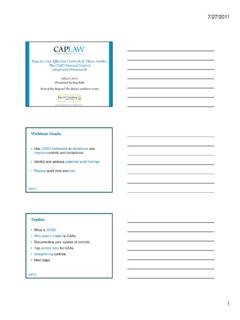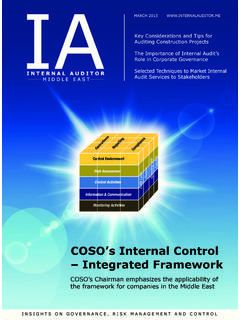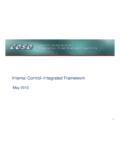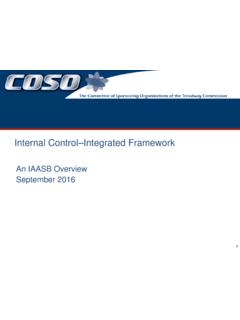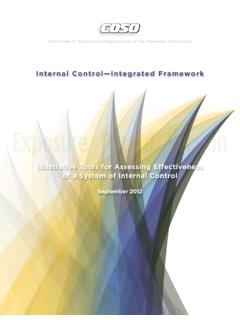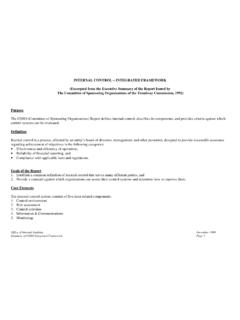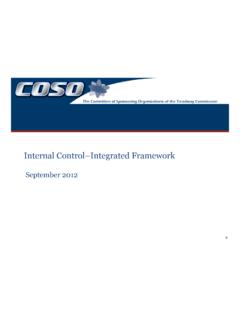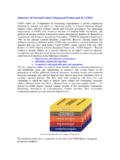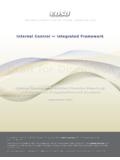Transcription of Guide for Self Assessment of Internal Controls
1 1 This document when completed may Consult the Office of Legal be classified a Public Record under Affairs if queried by external Chapter 132 of the NC General Statutes. parties on its contents. Guide for Self Assessment of Internal Controls Prepared by The Internal Audit Department Updated February 2016 Self Assessment of Internal Controls February 2016 This document when completed may Consult the Office of Legal be classified a Public Record under Affairs if queried by external Chapter 132 of the NC General Statutes. parties on its contents. 2 TABLE OF CONTENTS TOPIC PAGE Introduction 3 Internal control Overview 4 Elements of Internal control 5 Public Record Advisory 7 Internal control Self Assessment Questions A.
2 Integrity and Ethical Values 8 B. Management Philosophy and Operating Style 8 C. Organizational Structure 9 D. Assignment of Authority and Responsibility 9 E. Human Resource Policies and Procedures 9 F. General Financial 10 G. Cash Handling 10 H. Payroll 11 I. Safeguarding Assets 12 J. Administration of Sponsored Programs 12 K. Change and Petty Cash Funds 13 L. Information Technology Management 13 M. Purchasing 14 N. Miscellaneous Operations 15 Self Assessment of Internal Controls February 2016 This document when completed may Consult the Office of Legal be classified a Public Record under Affairs if queried by external Chapter 132 of the NC General Statutes. parties on its contents. 3 Self- Assessment of Internal Controls Introduction The UNC Charlotte Guide for Self- Assessment of Internal Controls is a tool adapted from the annual requirement administered to all state agencies by the Office of the State Controller (OSC).
3 The purpose of the OSC annual Assessment is to assist in confirming the presence of a sound system of Internal Controls . This Guide provides a streamlined set of questions intended to provide a vice chancellor, dean, associate dean, department chair, or department/center/agency/activity director with a self Assessment tool that will Guide him or her along the path of compliance with the many local, state and federal requirements to which we must adhere. The Guide is intended to be a companion tool to the Department Review Guide Self Assessment Version. You should complete the Internal Controls self Assessment first to identify those operational areas into which you need to look more closely. Some of the questions do not apply to every unit on campus. If this is the case for you, then answer N/A (not applicable). For those questions for which you are not sure of an answer or don t know the answer, write D/K (don t know).
4 After completing this Guide , refer to the Department Review Guide and conduct a more in-depth Assessment of your Internal operations in those areas marked No or D/K. The Department Review Guide asks a series of specific questions whose answers will complete a picture of how your unit performs in each area against the stated objective for that function. At the end of each section are the same two questions: What did you find? followed by Did you meet the stated objective? For those areas where you do not feel you meet the stated objective, use the Specific Subject Matter Reference Listing to seek guidance and advice on how to correct the issues that you have developed. Appendix A provides both a Guide and a template to the 2013 version of the COSO Controls framework broken down by component. This Guide is more in-depth and more free-form than the questionnaire sections. The Internal Audit Department recommends that you complete your initial assessments within the first six months of your assignment to a management position and periodically thereafter.
5 The tools can also be used as a desk reference by administrative staff and as orientation tools for New Employees. Any questions concerning the construction or content of either review Guide should be addressed to the Internal Audit Department using the consulting and advising request form found on our website. Self Assessment of Internal Controls February 2016 This document when completed may Consult the Office of Legal be classified a Public Record under Affairs if queried by external Chapter 132 of the NC General Statutes. parties on its contents. 4 Internal control Overview The following section regarding Internal control is taken from the May 2013 Internal control integrated framework Executive Summary published by the Committee of Sponsoring Organizations of the Treadway Commission (COSO).
6 Defining Internal control Internal control is defined as follows: Internal control is a process, effected by an entity s board of directors, management, and other personnel, designed to provide reasonable assurance regarding the achievement of objectives relating to operations, reporting, and compliance. This definition reflects certain fundamental concepts. Internal control is: Geared to the achievement of objectives in one or more categories operations, reporting, and compliance A process consisting of ongoing tasks and activities a means to an end, not an end in itself Effected by people not merely about policy and procedure manuals, systems, and forms, but about people and the actions they take at every level of an organization to affect Internal control Able to provide reasonable assurance but not absolute assurance, to an entity s senior management and board of directors Adaptable to the entity stricture flexible in application for the entire entity or for a particular subsidiary, division, operating unit, or business process This definition is intentionally broad.
7 It captures important concepts that are fundamental to how organizations design, implement, and conduct Internal control , providing a basis for application across organizations that operate in different entity structures, industries, and geographic regions. An effective system of Internal control demands more than rigorous adherence to policies and procedures: it requires the use of judgment. Management and boards of directors use judgment to determine how much control is enough. Management and other personnel use judgment every day to select, develop, and deploy Controls across the entity. Management and Internal auditors, among other personnel, apply judgment as they monitor and assess the effectiveness of the system of Internal control . Self Assessment of Internal Controls February 2016 This document when completed may Consult the Office of Legal be classified a Public Record under Affairs if queried by external Chapter 132 of the NC General Statutes.
8 Parties on its contents. 5 Components of Internal control Internal control consists of five integrated components: control Environment The control environment s the set of standards, processes, and structures that provide the basis for carrying out Internal control across the organization. The board of directors and senior management establish the tone at the top regarding the importance of Internal control including expected standards of conduct. Management reinforces expectations at the various levels of the organization. The control environment comprises the integrity and ethical values of the organization; the parameters enabling the board of directors to carry out its governance oversight responsibilities; the organizational structure and assignment of authority and responsibility; the process for attracting, develop retaining competent individuals; and the rigor around performance measures, incentives, and rewards to drive accountability for performance.
9 The resulting control environment has a pervasive impact on the overall system of Internal control . Risk Assessment Every entity faces a variety of risks from external and Internal sources. Risk is defined as the possibility that an event will occur and adversely affect the achievement of objectives. Risk Assessment involves a dynamic and iterative process for identifying and assessing risks to the achievement of objectives. Risks to the achievement of these objectives from across the entity are considered relative to established risk tolerances. Thus, risk Assessment forms the basis for determining how risks will be managed. A precondition to risk Assessment is the establishment of objectives, linked at different levels of the entity. Management specifies objectives within categories relating to operations, reporting, and compliance with sufficient clarity to be able to identify and analyze risks to those objectives. Management also considers the suitability of the objectives for the entity.
10 Risk Assessment also requires management to consider the impact of possible changes in the external environment and within its own business model that may render Internal control ineffective. control Activities control activities are the actions established through policies and procedures that help ensure that management s directives to mitigate risks to the achievement of objectives are carried out. control activities are performed at all levels of the entity, at various stages within business processes, and over the technology environment. They may be preventive or detective in nature and may encompass a range of manual and automated activities such as authorizations and approvals, verifications, reconciliations, and business performance reviews. Segregation of duties is typically built into the selection and development of control activities. Where segregation of duties is not practical, management selects and develops alternative control activities.
